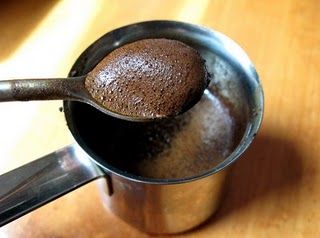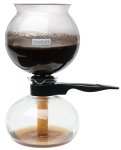Alas, we conclude our coffee series with some information and tips on various brewing techniques and some suggestions on experimentation with your own homebrew. Brewing a standard cup of coffee seems simple enough, but there are more factors in play than you might realize. For instance, since hot water acts as a solvent, your final cup will depend on how hot the water is (optimal temperature for solubility is 198-204° F, near but not at water’s boiling point); the amount of time the water stays in contact with the grinds; the grind texture (finer grinds have a higher surface area), and finally of course is the brew recipe (the water-to-coffee ratio). Adjusting these factors is necessary, lest you want a highly bitter or thin watery cup. Also, there are different brewing methods available, which yield different tastes to your cup.

There are six major methods of brewing, including:

– “Turkish” brewing: Very-finely ground coffee is mixed with boiling water and drunken as is, without removing the grounds. Often, this technique (popular in Turkey, Greece, and the Middle East) is brew with large amounts of sugar or spices like cardamon. The brew is very thick and rich, but may have higher levels of unhealthy compounds dissolved in your cup (see Coffee and You: Part 1 for information on these compounds). In Turkey, it’s common practice to tell one’s fortune with the arrangement of the grounds at the bottom of the cup.
– Concentrate brewing: Often found in Latin America, this method is simple: brew a bunch of coffee grinds with very little water for a long time. This resultant concentrate can be stored and used at your convenience to be mixed with hot or cold water and made into a full cup of coffee. The final cup has a weak aroma and light bodied, low-acid flavor.
– Percolating: Coffee grounds are continually brewed and rebrewed in boiling water. The coffee liquor is then reboiled. Though many prefer this technique, it’s considered a pretty poor practice in brewing, as the grounds are overextracted and burned in water that’s too hot.
– Vacuum brewing: A kind of tricky and science experiment-esque method involving two vacuum sealed globes (an upper and lower) with a filter typically inserted in between. Grinds are added to the upper globe, and the proportioned

amount of water is added to the lower globe. The water is heated from below, and with the consequent build up of pressure in the closed chamber, the water is forced upwards through a tube that connects to the upper globe. Once all the water is contained in this tube, the apparatus is removed from the heat source and the lower chamber experiences a drop in pressure. The pressure drop is the driving force for the hot water to suck down through the grind-filled upper globe and filter and back into the lower globe. Once it’s all dripped through, you can remove your desired coffee from the lower chamber and enjoy. The major pitfalls: the water used to extract the coffee is at boiling temperatures, and you have little control over the water-grinds contact time. It also seems needlessly complicated, if you ask me.
– Drip brewing, aka AutoDrop: What you know and love. Widely employed in the US, it only involves immersing grinds in hot (not boiling!) water to be slowly dripped down though a filter and collected in a pot. With the right coffee maker, it’s a great technique. Some but not all companies calibrate their coffee makers to heat the water to the ideal temperature. Besides being unable to regulate extraction time, the two additional disadvantages are that the filter paper fibers often impart a strange taste to the coffee and they absorb the tasty coffee bean oils from entering the brew. But the former issue can be easily remedied by rinsing your filter paper with hot water first, and both issues can be remedied by replacing your paper filter altogether with a reusable gold-plated filter.
– French Press brewing: Many argue that this is the superior method of brewing, because it allows complete control over all the variables of coffee making (water temperature, extraction time, etc.). Basically, coarsely ground coffee is placed into the bottom of a glass carafe, hot water is added, and a top is secured. After sufficient brew time (usually around 5 minutes), the top is removed and a plunger (consisting of a mesh filter and handle) is used to separate and push the grinds to the bottom of the container, while the coffee itself remains atop to be poured out. The brew product is said to be fuller bodied and flavored because the oils are permitted to intermingle with the brew, and one can easily adjust the temperature and brew time to make that perfect cup. The setbacks, however, include sediment in your cup and thus the possibility of intaking more cafestol and kahweol, which are potentially harmful to your health (but probably only in large quantities).
Regardless of how you brew your coffee, there is a staggering number of coffee drink concoctions that are totally worth trying. Some of these delicious sounding recipes can be found here, on Wikipedia, or for some spirited coffee beverages, check out here. Enjoy!
_____________________________________________________
Additional resources and credit:
http://www.sweetmarias.com/grind.brew.php
http://www.ineedcoffee.com/03/brewing/
http://www.coffeeresearch.org/coffee/brewing.htm

loved this series!
I also liked this series. However, I was disappointed that some of my favorite coffee brewing methods were not included. Such as:
The aeropress [http://www.sweetmarias.com/aeropress/aeropress_instructions.php] I recently got one of these for my 21st birthday. It was one of the best gifts I have ever received. The coffee it makes is SO mellow. Plus, it is dorm room safe! I get the water hot using my microwave.
The cheap-o stovetop method [http://www.youtube.com/watch?v=KqPjBi25-gI] This was featured on Hackcollege and is legitimately one of the easiest ways to make coffee. It is like a drip coffee maker but with slightly more control over factors like water temperature and contact with the beans.
I would love to see a follow-up to this series that goes behind the scenes at local coffee joints. Out of Duncan, Starbucks, Espresso Royale, and the various other places around campus who has the best cup of coffee?
Oh! Emma I wasn’t even aware of those methods– How awesome! Thanks for sharing, and I’m sorry I didn’t go too “out of the box” with some of these brewing techniques (blame my time crunch!). Next week I plan to write about bioacoustics… but, I will happily consider an extension on the coffee series with a behind-the-scenes feature on local coffee shops, at your great suggestion! If you or anyone for that matter have a local coffee shop you’d want to advocate, please let me know– Just comment below or email me. I’d love to hear what people’s favorite local places are, and I of course can add my input and/or do some personal research :)Thanks as always for reading!
In House and Steve’s Kitchen on Harvard Ave both have DELICIOUS (and reasonably-priced) coffee!